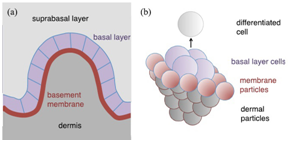 Interplay between epidermal stem cell dynamics and dermal deformation (表皮干细胞动力学与皮肤变形之间的相互作用)
Interplay between epidermal stem cell dynamics and dermal deformation (表皮干细胞动力学与皮肤变形之间的相互作用)
Yasuaki Kobayashi, Yusuke Yasugahira, Hiroyuki Kitahata, Mika Watanabe, Ken Natsuga & Masaharu Nagayama
npj Computational Materials 4:45 (2018)
doi:s41524-018-0101-z
Published online:20 August 2018
Abstract| Full Text | PDF OPEN
摘要:生命系统的形态变化由组织生长驱动。虽然屈曲不稳定性被认为是启动这种生长系统形成空间格局的关键因素,但屈曲不稳定性之外,人们对持续形态变化的基本原理却知之甚少。在哺乳动物皮肤中,真皮具有许多朝向表皮的突起,在突起的顶端通常分布着表皮干细胞。尽管屈曲理论联系有增殖细胞的真皮层和基底层可以很好地解释最初的不稳定性,但并不能决定那些突起的朝向,也不能决定表皮干细胞的空间分布。本研究在真皮和基底膜组成的可变形基底上,引入了基于粒子的、自我复制的细胞模型,并研究了真皮变形与真皮上表皮干细胞分布之间的关系。我们的模型再现了真皮突起从真皮长向表皮的形成过程,以及表皮干细胞在真皮突起顶端的优先分布,这是基础的屈曲机制所无法解释的。我们认为,特定类型的细胞与基底膜之间的粘附强度,是影响这些干细胞分布的关键因素。
Abstract:Tissue growth is a driving force of morphological changes in living systems. Whereas the buckling instability is known to play a crucial role for initiating spatial pattern formations in such growing systems, little is known about the rationale for succeeding morphological changes beyond this instability.In mammalian skin, the dermis has many protrusions toward the epidermis, and the epidermal stem cells are typically found on the tips of these protrusions.Although the initial instability may well be explained by the buckling involving the dermis and the basal layer, which contains proliferative cells, it does not dictate the direction of these protrusions, nor the spatial patterning of epidermal stem cells.Here we introduce a particle-based model of self-replicating cells on a deformable substrate composed of the dermis and the basement membrane, and investigate the relationship between dermal deformation and epidermal stem cell pattering on it.We show that our model reproduces the formation of dermal protrusions directing from the dermis to the epidermis, and preferential epidermal stem cell distributions on the tips of the dermal protrusions, which the basic buckling mechanism fails to explain.We argue that cell-type-dependent adhesion strengths of the cells to the basement membrane are crucial factors influencing these patterns.
Editorial Summary
Epidermal renewal: How cells find their place (表皮更新:细胞如何找到它们的位置)
我们的表皮每小时损失180万个皮肤细胞。这种损失要通过在表皮-真皮界面(即基底膜)处产生的新细胞来填补,这个基底膜有很多特殊的微笑皮肤突起。来自日本北海道大学的MasaharuNagayama团队,采用一种基于粒子的模型模拟了表皮更新。使用这种方法,作者发现持续的细胞分裂导致基底膜拥挤。依据能量消耗,细胞要么从基底膜上脱离,要么使基底膜变形继续留在其中,这样便形成真皮突起。该模型还解释了为什么干细胞会优先存在于这些突起的顶端。他们的模型不依赖于真皮之外的信号,可以作为其他系统分布格局形成的通用研究方法。
Our epidermis loses 1.8 million skin cells per hour. This loss is balanced by the generation of new cells at the epidermal-dermal interface, the basement membrane, which features characteristic dermal protrusions.A team led by MasaharuNagayama at Hokkaido University in Japan emulates epidermal renewal using a particle-based model.Using this approach, the authors uncover that constant cell division leads to crowding at the basement membrane.Depending on the energy cost, cells will either detach from the membrane or can be accommodated by deforming the membrane, thereby forming dermal protrusions.The model also explains observations that stem cells are preferentially found at the tips of these protrusions.The model does not rely on external signals from the dermis and could serve as a generic mechanism to other pattern-forming systems.


 沪公网安备 31010502006565号
沪公网安备 31010502006565号